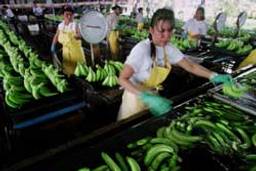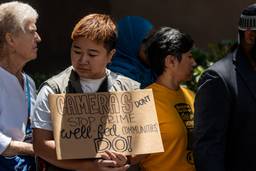
Last summer, after a worldwide plunge in coffee prices, thousands of unemployed coffee plantation workers in Nicaragua were forced to live in roadside camps. Conditions in the camps were appalling: Whole families were living in tents without adequate food supplies or sanitation facilities, and 45 percent of the children under five there suffered from chronic malnutrition, according to UNICEF and the Nicaraguan Health Ministry.
Low coffee prices and falling production have left more than 250,000 jobless in Nicaragua, says Fatima Ismael Espinoza, an agronomist with the coffee cooperative SOPPEXCCA. “People have died because of the slump in prices.”
Eventually, in mid-September, the government proposed measures to provide food, health care, work and even land, together with short-term financing and debt restructuring, for the coffee growers. In response, workers stopped blockading roads and marching to Managua, the capital, to protest the urgency of their situation.
Yet the cause of their plight—rock-bottom coffee prices on international markets—remains unsolved. Some 25 million coffee growers from Central and South America to Africa and Asia are now struggling to survive “the worst crisis coffee-producing countries have faced,” according to the International Coffee Organization (ICO). “They are facing a very difficult situation, with potential consequences of social and political disruption,” ICO Executive Director Néstor Osorio warned in October.
Coffee has lost half its selling price during the past few years, leading to a huge drop in export earnings for coffee-producing countries, where many farmers are no longer able to cover their cost of production. And there is little hope for a recovery in coming months, mainly due to an excess of global coffee stocks.
Aided by the launch of a major campaign by Oxfam in September, the rest of the world has begun to take notice. In mid-November, the U.S. House and Senate both passed unanimous resolutions urging private-sector buyers and roasters, such as Sara Lee, Kraft, Procter & Gamble and Nestlé, to cooperate in working out sustainable solutions.
The resolutions also called on President Bush to support “multilateral efforts to respond to the global coffee crisis”—a veiled call for the United States to rejoin the ICO. It left the organization in 1993 after the breakdown of an international quota system that had controlled coffee prices for almost three decades. The Cold War had provided an incentive for the United States to maintain the prices of commodities that provided livelihoods for farmers in developing countries. But when it ended, the government’s focus shifted to free trade, which conflicted with membership in initiatives like the ICO.
The ICO has formally invited the U.S. government to rejoin, and is now awaiting a response. “We don’t think there should be too much opposition,” says Pablo Dubois, head of operations at the ICO. “In the past, we had the quota system, but that no longer exists, removing some of the objections.” Indeed, both the National Coffee Association and the Specialty Coffee Association of America, the bodies representing the U.S. coffee industry, have publicly advocated a return to the ICO.
But not everyone is convinced the administration will be keen to go back to a multilateral system. “Recent political pressure has increased the chances,” says Jon Jacoby of Oxfam America. “But the indication is that [the Bush administration is] not ready to sit down at the table with others.”
Major roasting companies are also coming under pressure to participate in finding solutions to the crisis. Argues Phil Bloomer, director of the Oxfam campaign, “The coffee giants have presided over a vast expanse of human misery at the bottom of the supply chain, but have done almost nothing to prevent or solve it.”
The ICO wants the roasters to play a more active role in promoting coffee consumption. Oxfam goes further, calling on companies to use only coffee that meets basic ICO quality standards and to pay farmers “a decent price” (one that is above the cost of production). It also wants them to help fund the destruction of excess stocks and programs that help farmers diversify away from coffee, as well as increase the amount of coffee they buy under fair trade conditions.
Not surprisingly, roasters are reluctant to commit to such measures. But there are signs consumer pressure could change this. At a recent public debate in London, Hilary Parsons, head of corporate affairs for Nestlé United Kingdom, admitted that purchasing direct from farmers, which Nestlé has done on a limited basis, “is not the same as fair trade.” Roasters, she added, “will have to listen to the voices of consumers.”
In the United States, Jacoby reports that Procter & Gamble has shifted its stance in response to a flood of e-mails and letters from the public. Having previously ruled out participation in fair trade, it now says the door remains open.
In addition, opposition is growing to the injustice of a global trading system that allows developed countries to pay their farmers some $360 billion in annual subsidies. According to Bryan Lewin, an economist at the World Bank, those subsidies “wipe out the benefit of aid to the developing world,” which amounts to just $50 billion annually.
Moreover, subsidies and tariff barriers applied by the North to many agricultural products mean that farmers in the developing world simply can’t compete, deterring coffee growers from diversifying into other crops. Oxfam’s Bloomer says, “The challenge is to make trade fair. This is not about charity, but about solidarity in the face of human misery.”
In practice, SOPPEXCCA’s Ismael is very clear about what that means: “What we want is a fair price for our coffee. With that we can pursue our own development, without the need for people to offer us clothes or money for schools. … Buying coffee at prices that are too low, and then giving a loaf of bread with the other hand, is not the kind of solidarity we want.”
Low coffee prices and falling production have left more than 250,000 jobless in Nicaragua, says Fatima Ismael Espinoza, an agronomist with the coffee cooperative SOPPEXCCA. “People have died because of the slump in prices.”
Eventually, in mid-September, the government proposed measures to provide food, health care, work and even land, together with short-term financing and debt restructuring, for the coffee growers. In response, workers stopped blockading roads and marching to Managua, the capital, to protest the urgency of their situation.
Yet the cause of their plight—rock-bottom coffee prices on international markets—remains unsolved. Some 25 million coffee growers from Central and South America to Africa and Asia are now struggling to survive “the worst crisis coffee-producing countries have faced,” according to the International Coffee Organization (ICO). “They are facing a very difficult situation, with potential consequences of social and political disruption,” ICO Executive Director Néstor Osorio warned in October.
Coffee has lost half its selling price during the past few years, leading to a huge drop in export earnings for coffee-producing countries, where many farmers are no longer able to cover their cost of production. And there is little hope for a recovery in coming months, mainly due to an excess of global coffee stocks.
Aided by the launch of a major campaign by Oxfam in September, the rest of the world has begun to take notice. In mid-November, the U.S. House and Senate both passed unanimous resolutions urging private-sector buyers and roasters, such as Sara Lee, Kraft, Procter & Gamble and Nestlé, to cooperate in working out sustainable solutions.
The resolutions also called on President Bush to support “multilateral efforts to respond to the global coffee crisis”—a veiled call for the United States to rejoin the ICO. It left the organization in 1993 after the breakdown of an international quota system that had controlled coffee prices for almost three decades. The Cold War had provided an incentive for the United States to maintain the prices of commodities that provided livelihoods for farmers in developing countries. But when it ended, the government’s focus shifted to free trade, which conflicted with membership in initiatives like the ICO.
The ICO has formally invited the U.S. government to rejoin, and is now awaiting a response. “We don’t think there should be too much opposition,” says Pablo Dubois, head of operations at the ICO. “In the past, we had the quota system, but that no longer exists, removing some of the objections.” Indeed, both the National Coffee Association and the Specialty Coffee Association of America, the bodies representing the U.S. coffee industry, have publicly advocated a return to the ICO.
But not everyone is convinced the administration will be keen to go back to a multilateral system. “Recent political pressure has increased the chances,” says Jon Jacoby of Oxfam America. “But the indication is that [the Bush administration is] not ready to sit down at the table with others.”
Major roasting companies are also coming under pressure to participate in finding solutions to the crisis. Argues Phil Bloomer, director of the Oxfam campaign, “The coffee giants have presided over a vast expanse of human misery at the bottom of the supply chain, but have done almost nothing to prevent or solve it.”
The ICO wants the roasters to play a more active role in promoting coffee consumption. Oxfam goes further, calling on companies to use only coffee that meets basic ICO quality standards and to pay farmers “a decent price” (one that is above the cost of production). It also wants them to help fund the destruction of excess stocks and programs that help farmers diversify away from coffee, as well as increase the amount of coffee they buy under fair trade conditions.
Not surprisingly, roasters are reluctant to commit to such measures. But there are signs consumer pressure could change this. At a recent public debate in London, Hilary Parsons, head of corporate affairs for Nestlé United Kingdom, admitted that purchasing direct from farmers, which Nestlé has done on a limited basis, “is not the same as fair trade.” Roasters, she added, “will have to listen to the voices of consumers.”
In the United States, Jacoby reports that Procter & Gamble has shifted its stance in response to a flood of e-mails and letters from the public. Having previously ruled out participation in fair trade, it now says the door remains open.
In addition, opposition is growing to the injustice of a global trading system that allows developed countries to pay their farmers some $360 billion in annual subsidies. According to Bryan Lewin, an economist at the World Bank, those subsidies “wipe out the benefit of aid to the developing world,” which amounts to just $50 billion annually.
Moreover, subsidies and tariff barriers applied by the North to many agricultural products mean that farmers in the developing world simply can’t compete, deterring coffee growers from diversifying into other crops. Oxfam’s Bloomer says, “The challenge is to make trade fair. This is not about charity, but about solidarity in the face of human misery.”
In practice, SOPPEXCCA’s Ismael is very clear about what that means: “What we want is a fair price for our coffee. With that we can pursue our own development, without the need for people to offer us clothes or money for schools. … Buying coffee at prices that are too low, and then giving a loaf of bread with the other hand, is not the kind of solidarity we want.”








